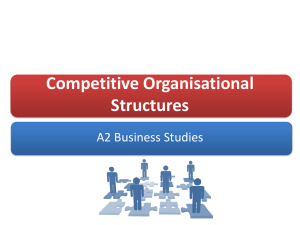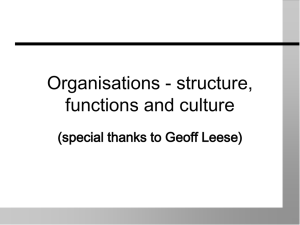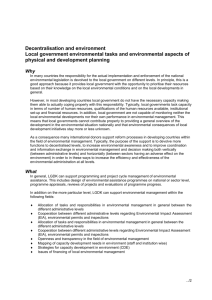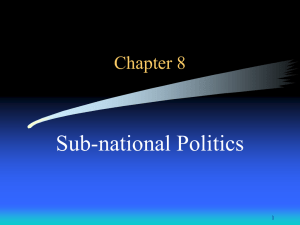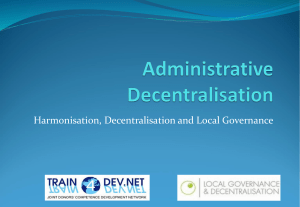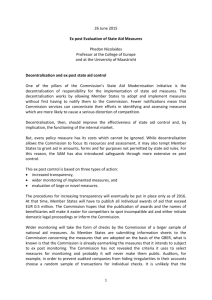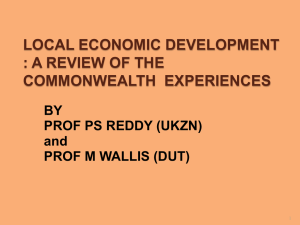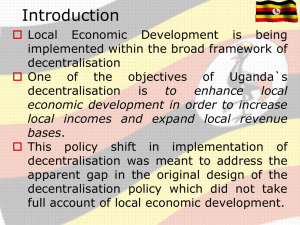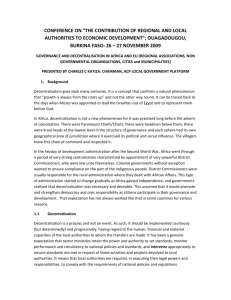PUBLIC SERVICE MOTIVATION
advertisement
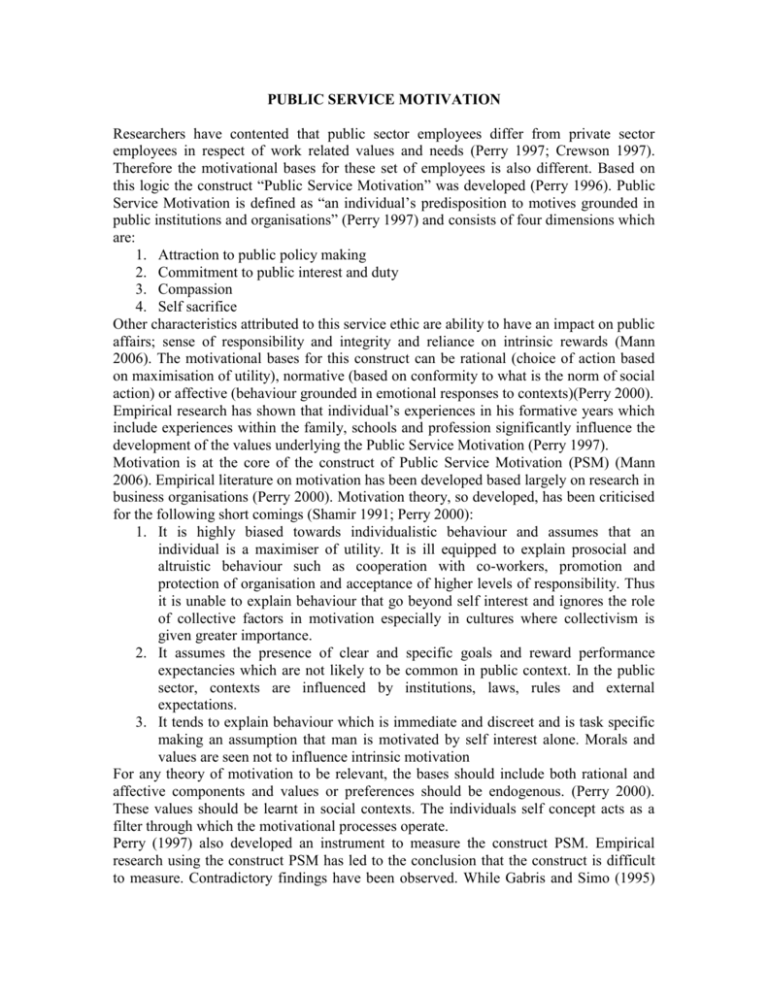
PUBLIC SERVICE MOTIVATION Researchers have contented that public sector employees differ from private sector employees in respect of work related values and needs (Perry 1997; Crewson 1997). Therefore the motivational bases for these set of employees is also different. Based on this logic the construct “Public Service Motivation” was developed (Perry 1996). Public Service Motivation is defined as “an individual’s predisposition to motives grounded in public institutions and organisations” (Perry 1997) and consists of four dimensions which are: 1. Attraction to public policy making 2. Commitment to public interest and duty 3. Compassion 4. Self sacrifice Other characteristics attributed to this service ethic are ability to have an impact on public affairs; sense of responsibility and integrity and reliance on intrinsic rewards (Mann 2006). The motivational bases for this construct can be rational (choice of action based on maximisation of utility), normative (based on conformity to what is the norm of social action) or affective (behaviour grounded in emotional responses to contexts)(Perry 2000). Empirical research has shown that individual’s experiences in his formative years which include experiences within the family, schools and profession significantly influence the development of the values underlying the Public Service Motivation (Perry 1997). Motivation is at the core of the construct of Public Service Motivation (PSM) (Mann 2006). Empirical literature on motivation has been developed based largely on research in business organisations (Perry 2000). Motivation theory, so developed, has been criticised for the following short comings (Shamir 1991; Perry 2000): 1. It is highly biased towards individualistic behaviour and assumes that an individual is a maximiser of utility. It is ill equipped to explain prosocial and altruistic behaviour such as cooperation with co-workers, promotion and protection of organisation and acceptance of higher levels of responsibility. Thus it is unable to explain behaviour that go beyond self interest and ignores the role of collective factors in motivation especially in cultures where collectivism is given greater importance. 2. It assumes the presence of clear and specific goals and reward performance expectancies which are not likely to be common in public context. In the public sector, contexts are influenced by institutions, laws, rules and external expectations. 3. It tends to explain behaviour which is immediate and discreet and is task specific making an assumption that man is motivated by self interest alone. Morals and values are seen not to influence intrinsic motivation For any theory of motivation to be relevant, the bases should include both rational and affective components and values or preferences should be endogenous. (Perry 2000). These values should be learnt in social contexts. The individuals self concept acts as a filter through which the motivational processes operate. Perry (1997) also developed an instrument to measure the construct PSM. Empirical research using the construct PSM has led to the conclusion that the construct is difficult to measure. Contradictory findings have been observed. While Gabris and Simo (1995) found no difference in employees of pubic, private and non-profit organisations in respect of perceived need for service and preference for intrinsic rewards, Brewer and Selden (1998), Lewis and Alonso (1999) and Crewson (1997) found that employees of public sector show a distinct preference for intrinsic rewards. Similarly research on the linkage between PSM and organisational performance is also mixed. While Naff and Crum (1999) found a positive relationship; Alonso and Lewis (2001) could not replicate the findings. Lewis and Frank (2002) found that persons who valued high income actually showed a greater preference for government service. Further, research using the construct has been plagued by the problems of validity. The studies have concentrated on finding differences between public and private sector employees and the scale used has distinction between intrinsic and extrinsic rewards as the basis. Because the respondents have been mainly public sector employees, there is an issue of social desirability response by the respondents. These validity issues gain strength in view of the fact that the construct PSM has been equated with prosocial behaviour (brewer 2002) and is seen more as a “service orientation” (Perry and Wise 1990) and is universal in nature and not restricted to employees in the public sector( Mann 2006). The construct PSM can be thus viewed as a mind set where the individual shows a preference for intrinsic rewards and is influenced by values of self sacrifice, responsibility and the urge to make an impact on the public affairs. In the organisation behaviour literature, organisation commitment has been proposed as a construct and attempts have been made to link it to motivation (Meyer, Becker and Vandenberghe 2004). They proposed an integrated model of commitment and motivation where both are considered as separate but related concepts. Commitment has been seen to be one among the many forces that form motivation. The model on motivation proposed by Locke (1997) sees goal setting as the central process. Goals can be self generated or given by others and proposes that values, personality traits and self efficacy perceptions shape the choice of internally generated goals and these factors are an outcome of experience and socialisation processes. Thus PSM can be viewed as a component of intrinsic motivation based on values of urge to make an impact on public affairs. Its linkage to organisational commitment can be inferred from the commonality of the bases for each of the construct. Both PSM and organisational commitment have rational, normative and affective bases. Organisation theory: a public perspective; gortner Harold f; Julianne Mahler and Jeanne bell Nicholson (1997) published by Harcourt brace college publishers fort worth USA Public organisations mean organisations created by some units of the government, be it local, state or federal government. They are part of the government and have as their purpose the administration of law. Term bureaucracy is used to identify a particular type of organisational structure. The bureaucracy; as defined by Weber; had the following characteristics: 1. Specialisation of functions 2. Hiring and promotion of officials based on expertise 3. Exercise of authority through a centralised hierarchical chain of command 4. Reduction of discretion available to individuals by development of rules Bureaus are usually seen where markets are lacking. And are usually oriented towards the efficiency of the proposed course of action and therefore lose their ability to act spontaneously with control becoming an overriding concern. A basic premise of organisation theory is that all formal organisations share similar traits and management is presumed to be a generic process with universal implications. Despite the fact that elements of organisations have remained relatively constant; the purposes, structures, ways of doing things and methods of coordination have varied widely. Public bureaus differ from private organisations. Although publicness and privateness are different qualities, organisations can be characterised along a continuum of lesser or greater publicness. The characteristics used to generate typologies are ownership and funding; extent of outside interference in policy decision making; and who benefits from the organisation. Public bureaus differ from private firms in their legal, economic and political roles. Legal issues: 1. Public bureaus are an integral part of the constitution and government and main purpose it to administer law. They have the backing of the legitimate force of the government and are empowered to act for publicly sanctioned purposes. Compliance with rules is mandatory. 2. The accountability of public bureaus is to the public at large and it does what the public or its elected representatives want. To ensure this power was diffused among institutions and levels within an institution. Due to this lines of authority are both external and internal, multiple and overlapping. 3. Managers in public bureaus can take action only in cases of grants of authority. Goals for public bureaus are established and limited by law. Thus administration is always subordinate to law. Private firms cab act as long as they do not contravene common law. Thus public managers must accomplish objectives set by others, resources allocated by others, and within a frame work established by law. Economic issues: 4. According to market theory private firms are to seek economic enhancement and governmental action is appropriate only when private resource allocations fails or becomes highly inefficient. However the “economic” role of the government is more political than economic and is a consequence of the extant historical and political forces. More than the economic functions, public agencies have the job of implementing non economic objectives (political). 5. Bureaus do not have economic output markets to indicate efficiency of production and ensure efficient resource allocation among firms competing. However bureau efficiency and effectiveness needs to be measured using multiple measures in relation to the functions and goals of the agency. Political exchange dominates a bureau’s transactions as their clientele are interest groups and political elites. Bureau’s internal characteristics vary according to the policy output. Political issues: 6. Politics has been defined as “who gets what, when and how” or as “authoritative allocation of values”. Bureaus interpret and implement this choice and thus are integral to the process of determining “who gets what, when and how”. Due to this reason they are participants in policy and political process. 7. Bureau’s are expected to be neutral and responsive to interest groups and therefore are expected to achieve consensus as part of their decision process, in face of conflicting interests. The involvement of interest groups in the policy process is due to the legal orders. 8. Public goals that direct the activities of a bureau are a result of an external political process and reflect a mixture of means and ends. Managers in bureaus are expected to achieve consensus among the interest groups over these goals. Generally these goals are worded in ambiguous terms and thus discretion is possible. This results in influencing the power of individuals in a bureau including the manager, the development of operating routines and the relations with the external groups. 9. Thus the climate of bureau characterised by external control and conflict among overseeing interest groups creates a climate of uncertainty, hostility and risk. Wagenaar, f pieter and mark r Rutgers (2004); symposium: caught between polis and empire; on centralisation and decentralisation in public administration theory; administrative theory and praxis, vol 26(4), 509-522 Centralisation versus decentralisation is a classic topic in the study of public administration but decentralisation is not promoted as countering centralisation. The origin of centralisation can be traced to the administrative reform in the US in the nineteenth century where there was a call to centralise, simplify and unify administrative institutions. The debate on centralisation versus decentralisation occurs under various forms such as democracy versus bureaucracy, authority versus autonomy and others. The debate also focuses on at three levels— 1. federal versus state government 2. state versus local government 3. local authority versus self government The topic is concerned with the hierarchical transfer of power or relations of influence. Centralisation and decentralisation concern the transfer of tasks and authority of a lower to a higher authority or vice versa (toonen 1987). Literature has shown that there seems to be a cycle of centralisation and decentralisation (kaufmann 1997). This occurs because the implementation of decentralisation does not occur at all levels and institutions for it to be effective; thus resulting in alternate calls for centralisation and decentralisation. Centralisation may be at odds with achievement of goals of social equity or democracy. If we trace the roots of western political theory, it can be seen that they link to nature of Greek polity and Roman administration. The Greek polity was very small in size and its administration needs therefore were very simple and minimal. Administration was considered part of need and serfdom and not part of freedom and morals. Roman Empire was much larger in size and more oligarchic and thus had greater needs for administration resulting in the creation of a centralised system of public administration. Hence the size of the domain to be administered is the key to whether there would be centralisation or not. Centralisation is linked to the concept of hierarchy where every layer above could exercise its authority on the layer below. The concepts of centralisation and decentralisation are also linked to the concepts of ascending or descending view of the government. The “descending” view of the government held the view that all power residing in god was given to the ruler who subsequently delegated it downwards. The “ascending” view looked to support freedom of choice and therefore lay stress on the individual and his rights. Ultimately for every polity, there is a trade off. With the increasing size of polity – be it economical or geographical – there is likely a loss of republican freedom. Size is considered an insurance against loss of freedom and therefore territorial expansion or trade and economic expansion (with the rise of political economy) there was a rise in centralisation due to increased demands of administration. An attempt to reconcile the conflicting demands of greatness and democracy led to the concept of “federalism”. Thus the debate on centralisation versus decentralisation is a debate between the need for political authority and managerial perspective. The managerial perspective is the need to implement the political decisions taken for the benefit of the society in consideration. Both the perspectives need to be considered. The need for centralisation can be for the following reasons (self 1982): 1. need for policy coordination—need for coordination of actions of multiple actors and organisations involved in policy implementation 2. need for resource coordination—need for coordination of resources to ensure efficiency 3. need for staff coordination—need to coordinate actors and their skills required to implement policy 4. need for technical coordination—need to manage and coordinate actions and information Similarly there can be drives for decentralisation. There can be a political drive to ensure maximum self determination; a resource drive to enable local adaptation; a staff drive to enable that expertise is not isolated and it becomes embedded and a technical drive to ensure continuity and ability to adapt to local variations. In view of the possibility of drives for both the concepts; Decentralisation need not be viewed as countering centralisation but as introduction of mechanisms to facilitate consultation and coordination in complex contexts. Thus it may actually increase the effectiveness of the system. Thus we see in the political approach to the issue of centralisation and decentralisation, the need for coordination and concentration of political power at the top level in the society. In the managerial approach, the same issue is treated as an internal organisational phenomenon. Thus increased centralisation is seen in form of increased overhead controls. Thus the important question is how are the two perspectives combined in practice? Level of control from centre(vertical centralisation) Level of control from local groups( horizontal centralisation) HIGH MEDIUM LOW LOW HIGH GOVERNANCE NETWORKS GOVERNANCE NETWORKS( through centrally controlled NGO’s) Centralisation through powerful NGO’s Total centralisation Horizontal decentralisation local autonomy Vertical decentralisation local autonomy Fluerke frederik and r willemse (2004); approaches to decentralisation and local autonomy: a critical appraisal; administrative theory and praxis; vol 26(4), pp 523544 The formal approach to decentralisation looks at it as a feature of administrative and political system. It is conceptualised
